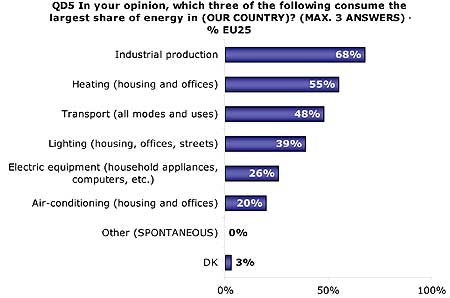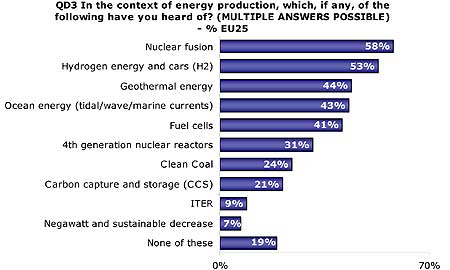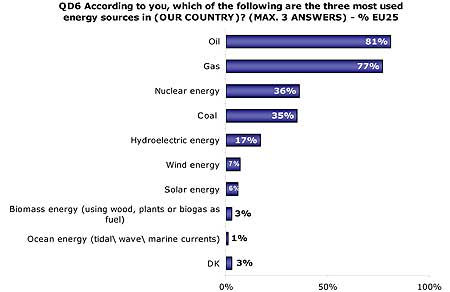
European
Nuclear Society
e-news
Issue 15 Winter 2006
http://www.euronuclear.org/e-news/e-news-15/eurobarometer.htm

At the beginning of January, the European Commission published the results of a Eurobarometer public opinion survey that it carried out last year among EU citizens on the subject of energy technologies. ENS NEWS has carried out a detailed analysis of the survey results for its readers and outlined (see below) the most salient statistics, including data on EU citizens’ general awareness of issues relating to nuclear and other energy sources and their views on research, fusion etc.
The results are a bit like the proverbial curate’s egg – good in some parts. And, of course, opinion polling is not a precise science, with statistics always subject to varying interpretations. So, you should draw your own conclusions. However, these extensive EU-wide surveys can reveal useful information about what EU citizens know and feel about key issues of the day.
It is important to bear in mind that the survey was carried out between May and June 2006, just after the Chernobyl accident’s 20th anniversary, and negative publicity could have influenced respondents’ views. Furthermore, the survey was carried out in the EU-25 and does not include the two new comers, Bulgaria and Romania - two nuclear countries where public opinion is very much in favour of nuclear energy. However one chooses to interpret the results, it cannot be denied that they certainly give food for thought.
Energy related issues seem to be of secondary importance
when compared to wider societal or economic issues. The Eurobarometer
on Energy Technology confirms that energy is not a major concern
or a top priority for EU citizens. It is a “back of mind issue”.
When the major social issues of the day are considered as a whole, EU citizens
rate energy issues (14%) far below unemployment (64%), crime (36%) and healthcare
systems (30%). Clearly, issues that relate more directly to daily life,
economic well-being, safety and health (p.9) are seen as priorities by most
EU citizens. However, other public opinion surveys on energy issues have
tended to show that views can evolve quickly (see Info Pool/Public Opinions
section of FORATOM’s web site:
www.foratom.org).
Only 1 in 5 citizens support the use of nuclear power (p.33). The percentage of people in favour of nuclear energy (20%) has decreased compared to that registered in the last Eurobarometer on Radioactive Waste, which was published in June 2005 (37%). However, only 37% of the interviewees are now clearly against it, which shows a decrease of around 20% (55% in the June 2005 Eurobarometer, p.26). Consequently, there is a greater proportion of respondents that are non-committal.
Looking thirty years ahead, Europeans anticipate a fundamental swing towards the use of renewable energies. The survey reveals that European citizens now rank nuclear energy as likely to be the third “most used” energy source in 30 years time - after solar (49%) and wind (40%). Nuclear energy is, therefore, expected to be a substantial part of the energy mix in the future (p.34-38). Four years ago, when the Eurobarometer on Energy was published, only 6% of EU citizens expected nuclear to be part of the energy mix in 20 years (p. 73, Eurobarometer, Energy: Issues, Options and technologies, December 2002).
In citizens’ minds, energy is most often
associated with high prices. A third (33%) of Europeans spontaneously
relate energy issues to prices and 45% consider that their government should
make guaranteeing low energy prices a top priority in their energy policy
(p.13-15). A majority of EU citizens also think that their country
is significantly dependent upon imported energy. 61% think that
their country is dependent upon energy imports. This degree of dependency
falls to 53% when respondents are asked to consider overall EU dependency
levels (p.20-21). Of course, these are issues where nuclear power can contribute
to finding the solution.

It is worth noting that in Sweden 30% of respondents think about nuclear power first where energy issues are concerned. The current debate about the phasing-out of nuclear power probably explains this trend. In 1980, the government decided to phase-out nuclear power after a referendum, but today nuclear power supplies half of the country’s electricity needs and a majority of Swedes are in favour of it. An opinion poll published in June 2006, which was commissioned by the Swedish Nuclear Safety and Training Centre (KSU) and conducted by the polling organisation TEMO, shows that public support for continuing to use nuclear power remains strong at 85%. The phase-out policy is, therefore, not in concert with the views of a majority of Swedes.
Over half of EU citizens have heard of nuclear
fusion (58%). The countries where the share of those knowing about
fusion is the largest are: Sweden (99%), The Netherlands (86%), Denmark
(72%), Germany (71%), France and Finland (69%) - (p. 12-13)

EU citizens are quite well aware of the fact that
nuclear power is one of the main energy sources in many European countries.
Nuclear power (36%) ranks third among the most used energy sources, according
to those surveyed, after oil (81%) and coal (77%). However, their views
are not completely accurate. In countries where nuclear power is the main
source of energy, like France and Lithuania, it is still only the third
most chosen answer (78% in France and 49% in Lithuania). (p.18-19)

Scientists top the credibility league: a majority of EU citizens consider scientists (71%) and environmental protection organisations (64%) to be the most trustworthy sources of accurate and useful information on energy issues. Energy companies rank fifth in the list (35%) ahead of journalists (31%) and national governments (29%) (p 24).
EU citizens attach considerable importance to energy-related research. 66% consider that it is a high priority and only a small amount of respondents considered research to be unimportant.
Readers can study the survey’s findings in more depth at the following
web link:
ec.europa.eu/public_opinion/archives/ebs/ebs_262_en.pdf
![]()
© European Nuclear Society, 2007